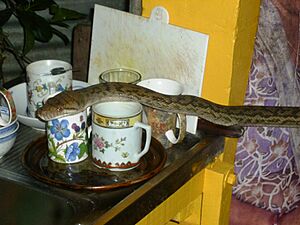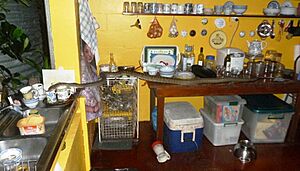Amethystine python facts for kids
Quick facts for kids Amethystine python |
|
|---|---|
 |
|
| Conservation status | |
| Scientific classification | |
| Genus: |
Simalia
|
| Species: |
amethistina
|
 |
|
| Synonyms | |
|
|
The amethystine python (Simalia amethistina), also known as the scrub python, is a very large snake. It is not venomous, meaning it doesn't have poison. This amazing snake belongs to the Pythonidae family.
You can find the amethystine python in Indonesia, Papua New Guinea, and Australia. It is popular among people who like reptiles. This snake is known for its beautiful colors and impressive size. It is one of the six largest snakes in the world, measured by how long it is or how much it weighs. It is also the biggest snake found naturally in Australia and Papua New Guinea.
What it's Called
In the Kalam language of Papua New Guinea, this snake is called nm.
Snake Family Tree
Scientists used to think there were five different types of Morelia amethistina, which they called subspecies. These included the main type, M. a. amethystina.
- The former M. a. tracyae lived in the Mollucan Islands, like Halmahera.
- A smaller type, the former M. a. nauta, was found in the Tanimbar Islands.
- On Seram Island, you could find the former M. a. clastolepis.
- The former M. a. amethystina was common in mainland Papua New Guinea and nearby islands.
- In Australia, the former M. a. kinghorni was found.
In 2014, scientists like Reynolds decided that all these types were different enough to be their own full species. They moved them into a new genus called Simalia. So now, they are known as Simalia amethistina, Simalia clastolepis, Simalia kinghorni, Simalia nauta, and Simalia tracyae.
The name amethistina comes from the milky, shiny look of its scales. This makes the snake look like it has the color of an amethyst gem.
What it Looks Like

Some amethystine pythons have been reported to be more than 8.5 meters (28 feet) long. However, snakes that are 5 meters (16 feet) long are already considered very big. It's rare to find a verified snake of this species longer than 6 meters (20 feet).
In 1990, a female snake found on Biak Island in Indonesia measured 6.88 meters (22 feet 7 inches). Another large female was measured at 7.2 meters (23.6 feet) in 1954. A typical adult snake is usually around 2 to 4 meters (6.5 to 13 feet) long.
Female pythons usually weigh about 15 kilograms (33 pounds). Some very large ones have been confirmed to weigh over 30 kilograms (66 pounds). There are stories of snakes weighing 90 kilograms (200 pounds), but these have not been officially proven. In 2015, a large scrub python nicknamed Scrubby was caught in Australia. It was 5 meters (16 feet) long and weighed about 50 kilograms (110 pounds). It was later released safely.
Male pythons are much smaller and thinner. They usually weigh about 5.1 kilograms (11 pounds) when they are grown. Sometimes, they can weigh more than 11 kilograms (24 pounds). The body of this snake is quite slim compared to other large python family members.
The smooth scales on its back are arranged in 39 to 53 rows around the middle of its body. It has deep heat-sensing pits on its lower lips. These pits help the snake find warm-blooded prey in the dark.
Where it Lives
The scrub python lives in Indonesia, including many islands like the Maluku Islands and Biak. It is also found in Papua New Guinea and many of its islands. In Australia, it lives on some islands in the Torres Strait and in northern Queensland.
This snake can be found in both wild bushland areas and even in suburbs. In Indonesia and tropical Queensland, it mostly lives in rainforests. It prefers warm, humid places that have good water sources. In northern Australia and New Guinea, it often lives in scrublands.
What it Eats
The amethystine python mainly eats birds, bats, rats, possums, and other small mammals. Larger snakes in Australia and Papua New Guinea can catch and eat wallabies and cuscus. They often wait by the banks of creeks and rivers for animals that come to drink water.
Gallery
-
S. amethistina from the Bronx Zoo in New York City.
Simalia amethistina at the TIGR Reptile Database. Accessed 14 February 2019.






